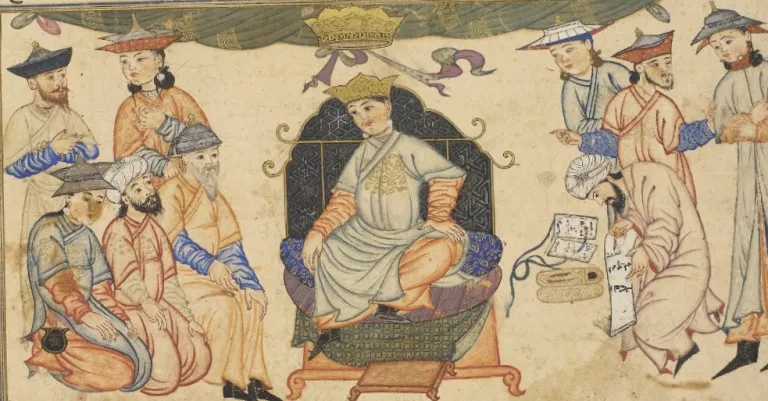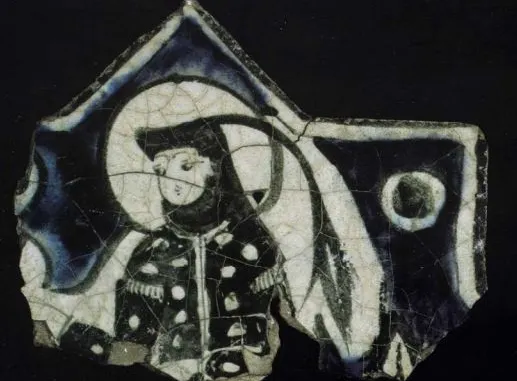Terken Hatun: A Powerful Woman in the Great Seljuk State: Perhaps the most striking title given to female sultans who were influential in state administration in our history is ”Terken”. When you look at it, the term ”Katun” (Hatun) was used without any changes for the ladies of the rulers and women members of the dynasty in the Turks from the Huns to the Karakhanids. Although there was no distinction in the social life of the Turkish states, we can say that there was such a distinction between the sultans and women in the palace; while almost all of the palace women had the title ”Katun” (Hatun), only the highest-ranking women could have the title ”Terken”.
Osman Turan, who made an important study on ”Terken”, which means ”obeyed”, drew attention to the similarity of the word ”Terken” to the word ”Türkan” in the plural form of Arabic letters. Another similarity is the title ”Tarkan” given to important commanders in ancient Turkish states. ”Tarkan” was used for brave commanders; ”Terken” was used for women who were influential in the palace and influential in the administration. Based on this, we can say that ”Terken” was added to the titles inspired by ”Tarkan”. There are also those who claim that the word ”Tengri” transformed into ”Terken” over time. Another point that Ziya Gökalp emphasized is the answer to the question of ”Türkan” or ”Terken”; women only had the title of Türkan (Terken) when they were queens. At this point, Osman Turan put an end to this discussion and stated that ”Türkan” was a name and ”Terken” was a title. Palace women with this title had their own fiefs (iktâ), divan organization, soldiers and treasuries. Due to this existence, Terken women, like the iktâ-holding lords in the feudal state system, took part in military interventions when necessary and had a say in the administration. In addition, not all women in the Seljuks stayed in the palace where the sultan was located, but stayed in palaces in other cities allocated to them permanently or temporarily.
Introduction to Terken Hatun: A Pioneering Female Leader
Terken Hatun was the granddaughter of Karakhanid Iligh Khan and the cousin of the ruler of Samarkand, Shams al-Mulk Abu’l-Hasan Nasr. Considering that the term “Iligh” was a title given to the ruler and the princes of his family in the Karakhanids, as in many other states, it is an undeniable fact that Terken Hatun was a woman from the Karakhanid dynasty. Reşidüddin Fazlullah referred to Terken Hatun as “Terken (Türkan) Hatun Sultan, the daughter of the Khan of Samarkand Tamgaç.” In the work “Selçuk-Nâme”, whose author is unknown, Terken Hatun is mentioned as “a queen of Turkish origin and Afrasyab lineage.” Terken Hatun, whose exact name is unknown, was also called “Celâliye Hatun”, based on the nickname “Celâlü’d-devle ve’d-din” of her husband Sultan Melikşah.

It is known that Terken Hatun was a very beautiful, sweet and pleasant woman and had great power. The attitudes she displayed towards the events that took place during her time reveal that she was a calm and self-confident person. The first of these attitudes can be seen in the marriage of Caliph Muqtadi to the daughter of Melikşah.
Caliph Muqtadi sent his vizier Fakhru’d-devle Abu Nasr b. Juheyr to Sultan Melikshah. Nizam al-Mulk, who was the vizier of Melikshah, took Fakhru’d-devle with him and brought him to Terken Hatun upon the order of Sultan Melikshah. When Fakhru’d-devle proposed marriage, Terken Hatun said that he wanted Mahmelek, the daughter of the Karakhanid rulers, and that the caliph could marry her daughter if he could meet the four hundred thousand dinars they offered. Fakhru’d-devle, who stated that no money could be demanded from the caliph, later reconciled with Terken Hatun and as a result, Terken Hatun’s conditions that the caliph would marry only his own daughter and spend every night with her were accepted. The sultan also agreed to this and Fakhru’d-devle returned to Baghdad. Afterwards, the wedding of Caliph Muqtadi and Mahmelek took place in 480 (1087).

Terken Hatun’s Political Marriage with Sultan Melikşah
Turkish states have commonly engaged in political marriages to develop their bilateral relations and to achieve certain ambitions for power. The sweet-talking, cheerful daughters of the rulers who were raised for their own interests were directed to such marriages when the time came. One of these political marriages was the marriage of the Sultan of the Great Seljuk State, Melikşah, and Terken Hatun. This marriage later ignited the fuse of events that accelerated the collapse of the Seljuk State.
Born in 447 (1055), Melikşah was nine years old when he married Terken Hatun. Melikşah’s young age indicates that such official marriages were held in the Middle Ages in Turkish-Islamic states before, did not reflect married life, and occurred later.
During his reign, Terken Hatun, who guided Sultan Melikshah in line with her own thoughts on many occasions, convinced Sultan Melikshah to pardon Mansur after the gifts sent to him by Nasrü’d-devle Mansur. Apart from this incident, when the ruler of Samarkand, Ahmed Khan, who was most likely his relative, was captured and taken prisoner, he was released from captivity as a result of Terken Hatun’s suggestions and the Western Karakhanids became subject to the Seljuks. In another example; Terken Hatun, who wanted to seize the Fars region held by Turanshah, gave an army to the command of Üner, one of Sultan Melikshah’s emirs, and directed him to set out on an expedition from Isfahan to Fars. Terken Hatun also constantly filled Sultan Melikshah in opposition to Nizam al-Mulk and insisted on appointing his own vizier, Tâcü’l-Mulk, to the post. As a result, she achieved her aim and caused a rift between Sultan Melikşah and Nizam al-Mulk. When Sultan Melikşah was on the Baghdad campaign and the vizier Nizam al-Mulk was killed by a Batini devotee, Terken Hatun made great progress towards her goal.

Efforts to Enthrone Terken Hatun’s Son Mahmud
Sultan Melikshah passed away in 485 (1092). Sultan Melikshah’s son Berkyaruk was in Isfahan at the time, while Terken Hatun was in Baghdad with her son Mahmud. Due to the intrigues that continued after his death, Sultan Melikshah could not even be mourned, let alone perform his funeral prayer. Keeping this death secret, Terken Hatun secretly persuaded the emirs and began to gather support to enthrone her son Mahmud, who was four years old. She also pardoned and released some important people who had been imprisoned by Melikshah, including Ibrahim ibn Quraysh ibn Bedran, the leader of the Beni Akil Tribe. Imam Ghazali, one of the great scholars of the period, issued a fatwa stating that Mahmud could not ascend to the throne because he was young. The Caliph’s son from Melikşah’s sister, Cafer, was given to Terken Hatun’s care. During this process, Terken Hatun brought the boy from Isfahan and handed him over to the Caliph. Thus, Terken Hatun, who made an agreement with the Caliph, placed Tâcü’l-mülk and Emir Üner next to her son Mahmud, whom she had nominally placed in the throne, and Tâcü’l-mülk gathered all the powers in his hands in order to govern the state on behalf of Terken Hatun.
Struggles with Berkyaruk
Terken Hatun sent the Emir of Mosul, Kürboğa, with the seal of Melikşah, to Isfahan, where Berkyaruk, her son’s most important rival, was, supported by the supporters of Nizâmü’l-mülk in the fight for the throne. Emir Kürboğa used the seal and took over the castle and Berkyaruk, acting as if it were the sultan’s order. After a while, Berkyaruk, who was taken prisoner in Isfahan, was rescued by the supporters of Nizâmü’l-mülk, and these supporters did not refrain from plundering the city. Later, when Berkyaruk came to the city of Rey, Terken Hatun sent soldiers to fight him. When Terken Hatun’s soldiers were defeated in this battle called Burûcird (485/1093), Berkyaruk laid siege to Isfahan. In response to this situation, Terken Hatun offered to pay Berkyaruk five hundred thousand dinars from her father’s inheritance and asked him to lift the siege of the city in return. Accepting this condition, Berkyaruk took his share of the treasury and retreated to Hamadan.

In this period when the ruler was uncertain, Terken Hatun, who wanted to take advantage of the authority gap, sought a strong alliance against Berkyaruk and sent a message to the emir of Azerbaijan, Ismail ibn Yakuti (Berkyaruk’s uncle), making a marriage proposal and also asking him to fight Berkyaruk. Accepting the offer, Ismail ibn Yakuti gathered soldiers from the Turkmens and other tribes and fought Berkyaruk near Kerec. Ismail ibn Yakuti, who was defeated in this war, came to Terken Hatun in Isfahan, where he was welcomed with great favor, and with his name included in sermons and coins, he maintained his place on the throne, albeit for a short time. Thinking that Ismail ibn Yakuti would seize power and eliminate them, the emirs – especially Emir Üner – decided to join Terken Hatun and Ismail ibn They opposed the marriage of Yâkuti. After the defeat he suffered in the war and because he was not wanted in the palace, Ismail ibn Yâkuti left Terken Hatun and sent a message to his sister Zübeyde Hatun, informing her that he had joined Berkyaruk’s side. Ismail ibn Yâkuti, whose real intention was to depose his nephew Berkyaruk and take the throne, conveyed this idea to the Seljuk emirs Gümüştegin el-Candar, Aksungur and Bozan, and was killed by them. Just like Terken Hatun’s emirs, Berkyaruk’s emirs also acted in this way out of fear of losing their own influence.
Legacy of Terken Hatun in the Great Seljuk State
After all these events, Terken Hatun, who was looking for a new way out, proposed marriage to the Seljuk general Tacü’d-devle Tutuş, the Melik of Syria. Tutuş, who took action on this proposal, set his mind on reaching Hamadan via Ahlat and Azerbaijan and fighting against Berkyaruk together with Terken Hatun. When you look at it, Tutuş, who intended to seize power like the previous kings, could not meet Terken Hatun, who set out to meet him. Terken Hatun had to return when she fell ill on the way and died a short time later in 487 (1094). In the following period, many throne struggles took place between Berkyaruk and Tutuş, and because of the ambitions of these two, many innocent people’s blood was shed – for no reason.
Terken Hatun, who used her intelligence and talents for her ambitions in power throughout her life, left behind many intrigues and enemies, but the Terken Hatun Madrasa allocated to the Hanafis in Baghdad and the domed section in the north of the courtyard of the Friday Mosque in Isfahan – one of the best examples of Islamic works – were built in her name.
Conclusion: The Impact of Terken Hatun’s Leadership
Terken Hatun, perhaps the most influential woman in the political arena of the Great Seljuk State, turned the Seljuk palace upside down with her talents and intelligence, coming from a noble family. She was always Sultan Melikşah’s guide in state affairs and protocol. Terken Hatun, who accepted the ambassador sent by the Caliph to ask for his daughter Mahmelek, managed to impose her own authority in this incident. Terken Hatun, who wanted to retain power after the death of her husband Melikşah, did not care that her son Mahmud was young and followed different methods to bring him to the throne. One of these was distributing a large portion of the treasury to the emirs so that they would be on her side. Terken Hatun, who also made political marriages when the time came in the struggle for power after the death of Sultan Melikşah, organized an army and sent it on a campaign to dominate the Persian region while her husband Sultan Melikşah was still alive. It would not be right to say that she did all of these just for the sake of gaining power and authority. When we look at it, it is true that the policies Terken Hatun followed weakened and weakened the state, but she implemented all of these just like the other dynasty women and even the kings, in order to have a say in the state’s rule. She never stepped back in doing these things that she believed were right for the survival and safety of the Great Seljuk State. It is necessary to prevent the wrong ideas about Terken Hatun, who is presented as a scapegoat within the state and the most effective name in the collapse of the state.
